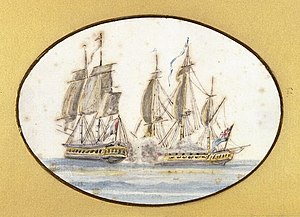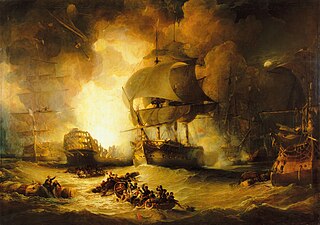
The Battle of the Nile was a major naval battle fought between the British Royal Navy and the Navy of the French Republic at Aboukir Bay on the Mediterranean coast off the Nile Delta of Egypt between 1–3 August 1798. The battle was the climax of a naval campaign that had raged across the Mediterranean during the previous three months, as a large French convoy sailed from Toulon to Alexandria carrying an expeditionary force under General Napoleon Bonaparte. The British fleet was led in the battle by Rear-Admiral Sir Horatio Nelson; they decisively defeated the French under Vice-Admiral François-Paul Brueys d'Aigalliers, destroying the best of the French navy, which was weakened for the rest of the Napoleonic Wars.
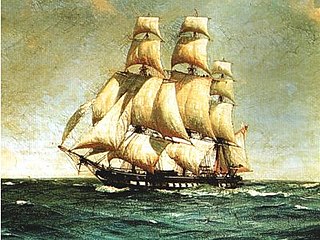
Sensible was a 32-gun Magicienne-class frigate of the French Navy. The Royal Navy captured her in 1798 off Malta and took into service as HMS Sensible. She was lost in a grounding off Ceylon in 1802.

The Mediterranean campaign of 1798 was a series of major naval operations surrounding a French expeditionary force sent to Egypt under Napoleon Bonaparte during the French Revolutionary Wars. The French Republic sought to capture Egypt as the first stage in an effort to threaten British India and support Tipu Sultan, and thus force Great Britain to make peace. Departing Toulon in May 1798 with over 40,000 troops and hundreds of ships, Bonaparte's fleet sailed southeastwards across the Mediterranean Sea. They were followed by a small British squadron under Rear-Admiral Sir Horatio Nelson, later reinforced to 13 ships of the line, whose pursuit was hampered by a lack of scouting frigates and reliable information. Bonaparte's first target was the island of Malta, which was under the government of the Knights of St. John and theoretically granted its owner control of the Central Mediterranean. Bonaparte's forces landed on the island and rapidly overwhelmed the defenders, securing the port city of Valletta before continuing to Egypt. When Nelson learned of the French capture of the island, he guessed the French target to be Egypt and sailed for Alexandria, but passed the French during the night of 22 June without discovering them and arrived off Egypt first.

The Battle of the Nile was a significant naval action fought during 1–3 August 1798. The battle took place in Aboukir Bay, near the mouth of the River Nile on the Mediterranean coast of Egypt and pitted a British fleet of the Royal Navy against a fleet of the French Navy. The battle was the climax of a three-month campaign in the Mediterranean during which a huge French convoy under General Napoleon Bonaparte had sailed from Toulon to Alexandria via Malta. Despite close pursuit by a British fleet of thirteen ships of the line, one fourth rate and a sloop under Sir Horatio Nelson, the French were able to reach Alexandria unscathed and successfully land an army, which Bonaparte led inland. The fleet that had escorted the convoy, consisting of thirteen ships of the line, four frigates and a number of smaller vessels under Vice-amiral François-Paul Brueys D'Aigalliers, anchored in Aboukir Bay as Alexandria harbour was too narrow, forming a line of battle that was protected by shoals to the north and west.

Vice-Admiral Sir Edward James Foote, KCB was a prominent Royal Navy officer during the late eighteenth and early nineteenth centuries. He served on a number of ships and at several actions, but is best known for becoming caught up in the aftermath of the collapse of the Parthenopean Republic at Naples in 1799. Foote had already signed a convention with rebel leaders assuring their safety when he was overruled by Lord Nelson. As a result, most of the rebels, including women, were executed. Nelson was heavily criticised for his role in the executions, but Foote failed to protest the decision until many years later, once Nelson was dead. This overshadowed his career and he did not serve in a position of responsibility again. He commanded the royal yacht during most of the Napoleonic Wars, and although he was knighted and continued to rise through the ranks post-war he did not see active service. He died in 1833 in Southampton.
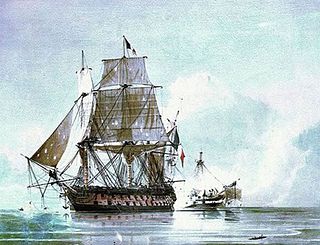
The action of 18 August 1798 was a minor naval engagement of the French Revolutionary Wars, fought between the British fourth rate ship HMS Leander and the French ship of the line Généreux. Both ships had been engaged at the Battle of the Nile three weeks earlier, in which a British fleet under Rear-Admiral Sir Horatio Nelson had destroyed a French fleet at Aboukir Bay on the Mediterranean coast of Egypt. Généreux was one of only four French ships to survive the battle, while Leander had been detached from the British fleet by Nelson on 6 August. On board, Captain Edward Berry sailed as a passenger, charged with carrying despatches to the squadron under Earl St Vincent off Cadiz. On 18 August, while passing the western shore of Crete, Leander was intercepted and attacked by Généreux, which had separated from the rest of the French survivors the day before.

The action of 15 July 1798 was a minor naval battle of the French Revolutionary Wars, fought off the Spanish Mediterranean coast by the Royal Navy ship of the line HMS Lion under Captain Manley Dixon and a squadron of four Spanish Navy frigates under Commodore Don Felix O'Neil. Lion was one of several ships sent into the Western Mediterranean by Vice-Admiral Earl St Vincent, commander of the British Mediterranean Fleet based at the Tagus in Portugal during the late spring of 1798. The Spanish squadron was a raiding force that had sailed from Cartagena in Murcia seven days earlier, and was intercepted while returning to its base after an unsuccessful cruise. Although together the Spanish vessels outweighed the British ship, individually they were weaker and Commodore O'Neil failed to ensure that his manoeuvres were co-ordinated. As a result, one of the frigates, Santa Dorotea, fell out of the line of battle and was attacked by Lion.

The siege of Malta, also known as the siege of Valletta or the French blockade, was a two-year siege and blockade of the French garrison in Valletta and the Three Cities, the largest settlements and main port on the Mediterranean island of Malta, between 1798 and 1800. Malta had been captured by a French expeditionary force during the Mediterranean campaign of 1798, and garrisoned with 3,000 soldiers under the command of Claude-Henri Belgrand de Vaubois. After the British Royal Navy destroyed the French Mediterranean Fleet at the Battle of the Nile on 1 August 1798, the British were able to initiate a blockade of Malta, assisted by an uprising among the native Maltese population against French rule. After its retreat to Valletta, the French garrison faced severe food shortages, exacerbated by the effectiveness of the British blockade. Although small quantities of supplies arrived in early 1799, there was no further traffic until early 1800, by which time starvation and disease were having a disastrous effect on the health, morale, and combat capability of the French troops.
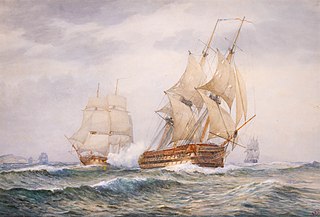
The Battle of the Malta Convoy was a naval engagement of the French Revolutionary Wars fought on 18 February 1800 during the Siege of Malta. The French garrison at the city of Valletta in Malta had been under siege for eighteen months, blockaded on the landward side by a combined force of British, Portuguese. and irregular Maltese forces and from the sea by a Royal Navy squadron under the overall command of Lord Nelson from his base at Palermo on Sicily. In February 1800, the Neapolitan government replaced the Portuguese troops with their own forces and the soldiers were convoyed to Malta by Nelson and Lord Keith, arriving on 17 February. The French garrison was by early 1800 suffering from severe food shortages, and in a desperate effort to retain the garrison's effectiveness a convoy was arranged at Toulon, carrying food, armaments and reinforcements for Valletta under Contre-amiral Jean-Baptiste Perrée. On 17 February, the French convoy approached Malta from the southeast, hoping to pass along the shoreline and evade the British blockade squadron.

The action of 31 March 1800 was a naval engagement of the French Revolutionary Wars fought between a Royal Navy squadron and a French Navy ship of the line off Malta in the Mediterranean Sea. By March 1800 Valletta, the Maltese capital, had been under siege for eighteen months and food supplies were severely depleted, a problem exacerbated by the interception and defeat of a French replenishment convoy in mid-February. In an effort to simultaneously obtain help from France and reduce the number of personnel maintained in the city, the naval commander on the island, Contre-amiral Pierre-Charles Villeneuve, ordered his subordinate Contre-amiral Denis Decrès to put to sea with the large ship of the line Guillaume Tell, which had arrived in the port shortly before the siege began in September 1798. Over 900 men were carried aboard the ship, which was to sail for Toulon under cover of darkness on 30 March.
The action of 19 December 1796 was a minor naval engagement of the French Revolutionary Wars, fought in the last stages of the Mediterranean campaign between two British Royal Navy frigates and two Spanish Navy frigates off the coast of Murcia. The British squadron was the last remaining British naval force in the Mediterranean, sent to transport the British garrison of Elba to safety under the command of Commodore Horatio Nelson. The Spanish under Commodore Don Jacobo Stuart were the vanguard of a much larger squadron. One Spanish frigate was captured and another damaged before Spanish reinforcements drove the British off and recaptured the lost ship.
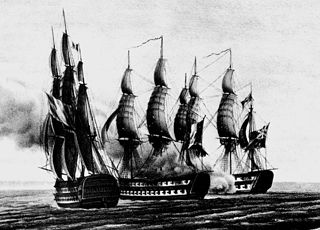
Ganteaume's expeditions of 1801 were three connected major French Navy operations of the spring of 1801 during the French Revolutionary Wars. A French naval squadron from Brest under Contre-amiral Honoré Ganteaume, seeking to reinforce the besieged French garrison in Ottoman Egypt, made three separate but futile efforts to reach the Eastern Mediterranean. The French army in Egypt had been trapped there shortly after the start of the Napoleonic campaign in Egypt in 1798, when the French Mediterranean Fleet was destroyed at the Battle of the Nile. Since that defeat, the French Navy had maintained only a minimal presence in the Mediterranean Sea, while the more numerous British and their allies had succeeded in blockading and defeating several French bases almost unopposed.

The action of 24 June 1801 was a minor naval engagement during the French Revolutionary Wars. A British ship of the line, HMS Swiftsure under Captain Benjamin Hallowell was passing westwards through the Southern Mediterranean near Cape Derna when it encountered a much larger French squadron under Contre-Amiral Honoré Ganteaume that was also returning westwards after a failed attempt to reinforce the besieged French garrison in Egypt. Although Hallowell immediately recognised the danger his vessel was in and turned to flee, the French ships were much faster and soon closed with his ship. At 14:00, three French vessels were within long gunshot and Hallowell decided that his only hope of escape lay in disabling the three ships before the rest of the French squadron could join the engagement. Turning towards the enemy, Hallowell found that his sluggish ship was unable to respond rapidly to French manoeuvres and within two hours Swiftsure was surrounded. Threatened with complete destruction and unable to escape, the British captain surrendered.

The action of 19 February 1801 was a minor naval battle fought off Ceuta in Spanish North Africa in February 1801 between frigates of the French and Royal Navies during the French Revolutionary Wars. The engagement formed part of a series of actions fought to prevent the French from resupplying their garrison in Egypt, which had been trapped there without significant reinforcement since the defeat of the French Mediterranean Fleet at the Battle of the Nile two and a half years earlier. The leader of the Egyptian expedition, General Napoleon Bonaparte, had returned to France in 1799 and promised aid to the troops left behind, prompting several expeditions to the region carrying reinforcements.

The action of 13 October 1796 was a minor naval engagement of the French Revolutionary Wars, fought off the Mediterranean coast of Spain near Cartagena between the British Royal Navy 32-gun frigate HMS Terpsichore under Captain Richard Bowen and the Spanish Navy 34-gun frigate Mahonesa under Captain Tomás de Ayalde. The action was the first battle of the Anglo-Spanish War, coming just eight days after the Spanish declaration of war. In a battle lasting an hour and forty minutes, Mahonesa was captured.

The Algeciras campaign was an attempt by a French naval squadron from Toulon under Contre-Admiral Charles Linois to join a French and Spanish fleet at Cadiz during June and July 1801 during the French Revolutionary Wars prior to a planned operation against either Egypt or Portugal. To reach Cadiz, the French squadron had to pass the British naval base at Gibraltar, which housed the squadron tasked with blockading Cadiz. The British squadron was commanded by Rear-Admiral Sir James Saumarez. After a successful voyage between Toulon and Gibraltar, in which a number of British vessels were captured, the squadron anchored at Algeciras, a fortified port city within sight of Gibraltar across Gibraltar Bay. On 6 July 1801, Saumarez attacked the anchored squadron, in the First Battle of Algeciras. Although severe damage was inflicted on all three French ships of the line, none could be successfully captured and the British were forced to withdraw without HMS Hannibal, which had grounded and was subsequently seized by the French.

The action of 26 April 1797 was a minor naval engagement during the French Revolutionary Wars in which a Spanish convoy of two frigates was trapped and defeated off the Spanish town of Conil de la Frontera by British ships of the Cadiz blockade. The British vessels, the ship of the line HMS Irresistible and the Fifth-rate frigate HMS Emerald, were significantly more powerful than the Spanish frigates, which were on the last stage of a voyage carrying treasure from Havana, Cuba, to the Spanish fleet base of Cadiz.

The action of 16 October 1799 was a minor naval engagement during the French Revolutionary Wars between a squadron of British Royal Navy frigates and two frigates of the Spanish Navy close to the Spanish naval port of Vigo in Galicia. The Spanish ships were a treasure convoy, carrying silver specie and luxury trade goods across the Atlantic Ocean from the colonies of New Spain to Spain. Sighted by British frigate HMS Naiad enforcing the blockade of Vigo late on the 15 October, the Spanish ships were in the last stages of their journey. Turning to flee from Naiad, the Spanish soon found themselves surrounded as more British frigates closed in.
The Croisière de Bruix was the principal naval campaign of the year 1799 during the French Revolutionary Wars. The expedition began in April 1799 when the bulk of the French Atlantic Fleet under Vice-Admiral Étienne Eustache Bruix departed the base at Brest, evading the British Channel Fleet which was blockading the port and tricking the commander Admiral Lord Bridport into believing their true destination was Ireland. Passing southwards, the French fleet narrowly missed joining with an allied Spanish Navy squadron at Ferrol and was prevented by an easterly gale from uniting with the main Spanish fleet at Cádiz before entering the Mediterranean Sea. The Mediterranean was under British control following the destruction of the French Mediterranean Fleet at the Battle of the Nile in August 1798, and a British fleet nominally under Admiral Earl St Vincent was stationed there. Due however to St. Vincent's ill-health, operational control rested with Vice-Admiral Lord Keith. As Keith sought to chase down the French, the Spanish fleet followed Bruix into the Mediterranean before being badly damaged in a gale and sheltering in Cartagena.

The Mediterranean campaign of 1793–1796 was a major theater of conflict in the early years of the French Revolutionary Wars. Fought during the War of the First Coalition, the campaign was primarily contested in the Western Mediterranean between the French Navy's Mediterranean Fleet, based at Toulon in Southern France, and the British Royal Navy's Mediterranean Fleet, supported by the Spanish Navy and the smaller navies of several Italian states. Major fighting was concentrated in the Ligurian Sea, and focused on British maintenance of and French resistance to a British close blockade of the French Mediterranean coast. Additional conflict spread along Mediterranean trade routes, contested by individual warships and small squadrons.

